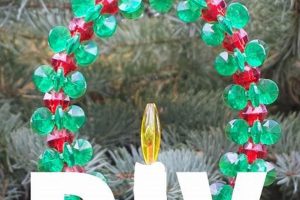The creation of personalized holiday decorations involving photographs encased in handcrafted frames allows for the unique expression of individual style and cherished memories. For instance, family portraits placed within miniature, self-made frames can be hung on a Christmas tree, adding a personal touch to festive celebrations.
This activity offers several advantages, including the fostering of creativity, the preservation of sentimental value, and the development of fine motor skills, particularly for younger participants. Historically, handmade ornaments have represented a way to celebrate traditions and reinforce familial bonds, providing a tangible representation of shared experiences.
This exposition will further explore material selection, construction techniques, and design considerations for producing visually appealing and structurally sound personalized photographic keepsakes for seasonal display. Detailed instructions and potential variations will be provided.
Essential Guidance for Crafting Personalized Photo Adornments
The subsequent advice ensures durable and aesthetically pleasing results when constructing miniature framed photographic decorations. Careful consideration of these points enhances the final product and minimizes potential issues during the assembly process.
Tip 1: Material Selection: Opt for acid-free cardstock or wood to prevent photo degradation over time. Ensure compatibility between adhesives and photo paper to avoid discoloration or damage.
Tip 2: Precision Cutting: Employ a craft knife and ruler or a die-cutting machine for accurate frame shapes. Precise cuts contribute to a professional and polished appearance.
Tip 3: Secure Photo Mounting: Utilize photo-safe double-sided tape or adhesive dots to firmly affix the photograph within the frame. Avoid liquid glues that can warp or stain the image.
Tip 4: Frame Reinforcement: Strengthen fragile frames with additional layers of cardstock or thin wooden supports. Reinforcement enhances durability and prevents breakage during handling and storage.
Tip 5: Hanging Mechanism Integration: Securely attach ribbon, twine, or ornament hooks using strong adhesives or small brads. Proper attachment ensures the ornament hangs straight and remains intact.
Tip 6: Sealing and Protection: Apply a thin coat of sealant or varnish to protect the finished frame from moisture and dust. This extends the ornament’s lifespan and maintains its visual appeal.
Tip 7: Edge Finishing: Sand or file down any rough edges on wooden or cardstock frames for a smooth and comfortable finish. Refined edges enhance the overall aesthetic and prevent snags.
Adhering to these guidelines will result in personalized photographic decorations that are both visually appealing and structurally sound, capable of withstanding seasonal display and storage.
The subsequent sections will delve into advanced design concepts and embellishment techniques for those seeking to elevate the artistry of their handcrafted photographic keepsakes.
1. Material Selection
Material selection represents a foundational element in the successful creation of handcrafted photographic decorations. The materials chosen directly impact the durability, aesthetic quality, and archival potential of the finished product. Inferior materials can lead to premature degradation of both the frame and the enclosed photograph, diminishing the keepsake’s long-term value. For example, using acidic cardboard for the frame’s backing can cause the photograph to yellow and become brittle over time. Conversely, employing acid-free cardstock or wood provides a protective barrier, preserving the image’s integrity for decades. Therefore, selecting appropriate materials is not merely a matter of aesthetics, but one of long-term preservation.
Furthermore, the choice of materials influences the overall aesthetic of the photographic decoration. Wooden frames offer a rustic or traditional appeal, while metallic cardstock provides a more modern or glamorous look. The adhesive used to secure the photograph within the frame also plays a critical role. Certain adhesives can bleed or discolor the photograph, ruining the image. Photo-safe adhesives, specifically designed for archival purposes, are essential for preventing such damage. The type of sealant or varnish applied to the finished frame also impacts its resistance to moisture and fading. A high-quality, UV-resistant sealant will protect the ornament from environmental damage, ensuring its continued beauty.
In summary, material selection is an indispensable consideration in the construction of personalized photo adornments. Careful evaluation of material properties, archival suitability, and aesthetic qualities is necessary to ensure the creation of durable, visually appealing, and emotionally resonant keepsakes. Failure to prioritize material selection can result in the premature deterioration of both the frame and the photograph, undermining the purpose of creating a lasting memento. This underscores the practical significance of understanding the connection between materials and the longevity of these handcrafted ornaments.
2. Frame Construction
Frame construction represents a pivotal stage in the creation of handcrafted photographic ornaments, directly influencing structural integrity and aesthetic presentation. The method of construction determines the ornament’s durability and visual appeal, impacting its ability to withstand handling and display.
- Cutting and Shaping Techniques
The precision with which materials are cut and shaped dictates the overall quality of the frame. Accurate measurements and clean cuts are essential for creating a professional-looking ornament. Examples include using a craft knife and ruler for cardstock frames or employing a saw for wooden frames. Inaccurate cuts can lead to uneven edges and a poorly constructed frame, negatively affecting the final product.
- Joining Methods
The method used to join the frame’s components significantly affects its strength and stability. Adhesives, such as glue or double-sided tape, are commonly used, but the choice of adhesive must align with the frame material. For instance, wood glue is suitable for wooden frames, while photo-safe adhesive is crucial for preserving photograph integrity when adhering it to the frame. Inadequate joining can result in a fragile frame prone to breakage.
- Material Reinforcement
Reinforcing the frame structure is crucial, particularly for delicate materials like cardstock. Additional layers of material or the incorporation of reinforcing elements, such as thin wooden supports, can significantly enhance the frame’s durability. Lack of reinforcement can lead to bending or warping, especially under the weight of the photograph or additional embellishments.
- Finishing Techniques
The finishing applied to the frame construction greatly impacts the final look and feel. Sanding rough edges, applying paint or varnish, and sealing the surface contribute to a polished and durable ornament. Incomplete or careless finishing can result in a less appealing and more vulnerable ornament, affecting its longevity and aesthetic value.
Collectively, these facets of frame construction are crucial for producing durable and visually pleasing ornaments. Careful attention to cutting, joining, reinforcement, and finishing ensures that the resulting photographic decoration is a lasting keepsake. Conversely, neglecting these elements can compromise the ornament’s integrity, diminishing its value and appeal. Therefore, skilled execution of frame construction is fundamental to the successful creation of handcrafted photographic ornaments.
3. Photo Integration
Photo integration is a critical process in the creation of handcrafted photographic ornaments, directly impacting the ornament’s emotional resonance and visual storytelling. The seamless incorporation of a photograph within the frame structure is paramount to realizing the ornament’s intended purpose: to preserve and showcase cherished memories. Poorly executed photo integration can detract from the photograph itself, rendering the ornament ineffective as a sentimental keepsake. For example, an image inadequately secured within the frame may shift or become dislodged, distorting the visual presentation and diminishing the ornament’s value.
The practical aspects of photo integration involve several key considerations. The size and shape of the photograph must be carefully matched to the frame’s dimensions to ensure a proper fit and aesthetically pleasing presentation. Appropriate adhesives, such as photo-safe double-sided tape or adhesive dots, must be employed to prevent damage to the photograph over time. In contrast, using liquid glues can cause warping, discoloration, or irreversible damage to the image. Furthermore, the method of mounting should ensure the photograph lies flat and remains securely in place, preventing unsightly bubbling or wrinkling. Some crafters also choose to protect the photograph behind a transparent layer, such as acetate or glass, for added durability and preservation.
In summary, photo integration is an indispensable step in the creation of personalized photographic decorations. Attention to detail in sizing, adhesive selection, and mounting techniques is vital to ensure the photograph is displayed optimally and remains protected for years to come. Failing to properly integrate the photograph not only compromises the ornament’s visual appeal but also undermines its fundamental purpose as a cherished memento, reinforcing the need for careful execution in this critical aspect of the crafting process.
4. Design Embellishments
Design embellishments are integral to the personalized expression afforded by handcrafted photographic decorations. The addition of decorative elements transforms a basic frame into a unique and meaningful keepsake, reflecting individual artistic preferences and enhancing the ornament’s visual impact. The absence of embellishments can result in a plain or unremarkable ornament, failing to fully capture the intended sentimental value. For example, a simple wooden frame can be enhanced with hand-painted details, glitter accents, or miniature decorative elements that complement the photograph’s subject matter.
The selection and application of design embellishments involve careful consideration of materials, techniques, and aesthetic principles. Paint, glitter, beads, ribbons, and small craft items can be strategically incorporated to enhance the ornament’s visual appeal. The choice of embellishments should align with the photograph’s theme and the overall design aesthetic. For instance, a photograph of a winter scene might be complemented by snowflake-shaped glitter or miniature icicles, while a photograph of a child might be enhanced with colorful paint or playful ribbons. Techniques such as decoupage, stenciling, or hand-painting can be employed to apply embellishments with precision and artistry. The skillful execution of these techniques is crucial to achieving a polished and professional appearance.
In essence, design embellishments are critical for elevating the artistry and personal significance of handcrafted photographic decorations. Thoughtful and well-executed embellishments transform a simple frame into a cherished keepsake, adding a layer of visual interest and emotional resonance. Challenges may arise in achieving a balanced and cohesive design, requiring careful planning and experimentation. Nonetheless, the addition of design embellishments is a fundamental aspect of creating personalized ornaments that capture memories and reflect individual creativity, solidifying their importance in the craft.
5. Hanging Mechanism
The hanging mechanism constitutes a crucial, often understated, element in the overall functionality and presentation of handcrafted photographic ornaments. The connection between the hanging mechanism and the ornament itself is one of direct dependency; without a secure and appropriate means of suspension, the ornament cannot fulfill its intended purpose of being displayed. The choice of mechanism directly impacts the ornament’s stability, aesthetic integration, and long-term durability. For example, a poorly affixed ribbon or a weak metal hook can cause the ornament to fall and potentially break, negating the time and effort invested in its creation. This highlights the cause-and-effect relationship, where a deficient hanging mechanism leads to the failure of the entire ornament.
The practical significance of a well-designed hanging mechanism is evident in various scenarios. Consider an ornament made of delicate materials, such as thin wood or intricate paper. In such cases, a lightweight and unobtrusive hanging mechanism, like a fine silk thread or a small, delicate wire, is essential to avoid adding excessive weight or detracting from the ornament’s aesthetic. Conversely, a heavier ornament, such as one constructed from resin or embellished with substantial components, necessitates a sturdier hanging mechanism, perhaps a reinforced metal hook or a robust cord, to ensure secure suspension. Real-world examples of successful hanging mechanisms include the use of concealed wire loops integrated directly into the frame’s structure or the attachment of decorative ribbon loops using strong adhesive specifically designed for crafts. Therefore, the hanging mechanism is not simply an afterthought but rather an integral design consideration.
In conclusion, the hanging mechanism is inextricably linked to the success of “diy picture frame ornaments”. Its design and implementation must be thoughtfully considered to ensure the ornament’s safe and stable display. While the visual embellishments and photographic element capture attention, a robust and well-integrated hanging mechanism is the silent enabler, guaranteeing that the handcrafted memento can be enjoyed for years to come. Challenges can arise in achieving a balance between functionality and aesthetics, but prioritizing a secure and appropriate hanging mechanism is paramount to realizing the ornament’s full potential.
Frequently Asked Questions
The following section addresses common inquiries regarding the construction, materials, and preservation of personalized picture frame ornaments. These questions aim to provide clarity and guidance for individuals engaging in this craft.
Question 1: What materials are best suited for creating durable and long-lasting photographic ornaments?
Archival-quality materials, such as acid-free cardstock, wood, or metal, are recommended for the frame construction. Photo-safe adhesives and UV-resistant sealants are essential for protecting the photograph from degradation.
Question 2: How can photographs be securely mounted within the frame to prevent shifting or damage?
Photo-safe double-sided tape or adhesive dots are recommended for mounting photographs. Avoid liquid glues, as they can warp the image. Ensure the photograph is properly sized to fit snugly within the frame opening.
Question 3: What techniques can be used to reinforce fragile frame structures, such as those made from cardstock?
Additional layers of cardstock or thin wooden supports can be added to the frame’s back or edges to provide reinforcement. Consider using a thicker gauge of cardstock or employing corner reinforcements.
Question 4: How can the hanging mechanism be securely attached to the ornament to prevent breakage or detachment?
Use strong adhesives, such as epoxy or craft glue, to attach the hanging mechanism. Reinforce the attachment point by using brads or small screws. Ensure the hanging mechanism is appropriately sized to support the ornament’s weight.
Question 5: What methods can be employed to protect the finished ornament from moisture, dust, and fading?
Apply a thin coat of sealant or varnish specifically designed for crafts. Ensure the sealant is UV-resistant to protect the photograph from fading. Store the ornament in a dry, dust-free environment when not on display.
Question 6: What are some common mistakes to avoid when creating handcrafted photographic decorations?
Avoid using acidic materials, liquid glues, or adhesives that are not photo-safe. Ensure accurate measurements and precise cuts during frame construction. Do not overload the ornament with excessive embellishments. Allow adhesives and sealants to fully cure before handling or displaying the ornament.
The information provided addresses key considerations for creating high-quality, personalized photographic ornaments. Adhering to these guidelines will enhance the durability, longevity, and aesthetic appeal of the finished products.
The following section will explore advanced design concepts and creative embellishment techniques for those seeking to further enhance their handcrafted photographic keepsakes.
Conclusion
This exposition has systematically examined the creation of personalized photographic ornaments, delineating the critical aspects of material selection, frame construction, photo integration, design embellishments, and hanging mechanisms. These elements, when thoughtfully considered and meticulously executed, contribute to the production of enduring and emotionally resonant keepsakes.
The enduring appeal of diy picture frame ornaments resides in their capacity to capture and preserve cherished memories. Their creation constitutes a meaningful activity, fostering both creativity and a tangible connection to personal history. Continued exploration and refinement of techniques will undoubtedly enhance the quality and significance of these handcrafted mementos.







